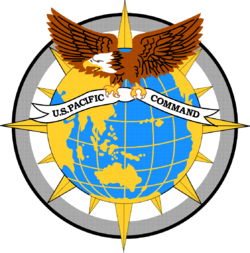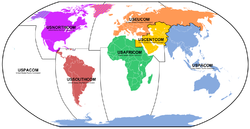- United States Pacific Command
-
United States Pacific Command 
Emblem of the United States Pacific Command.Active 1947–present Country United States Type Unified Combatant Command Headquarters Camp H. M. Smith, in Halawa Heights, Hawaii Nickname USPACOM Engagements Korean War, Vietnam War Commanders Combatant Commander Admiral Robert F. Willard, USN Deputy Commander Lieutenant General Daniel J. Darnell, USAF The United States Pacific Command (USPACOM) is a Unified Combatant Command of the United States armed forces . It is led by the Commander, Pacific Command (CDRUSPACOM), who is the supreme military authority for the various branches of the Armed Forces of the United States serving within its area of responsibility (AOR). The chain of command runs from the President of the United States, through the Secretary of Defense, to the Commander, Pacific Command.[1] It is the oldest and largest of the ten Unified Combatant Commands. It is based in Honolulu, Hawai'i on the island of O'ahu.
The main combat power of USPACOM is formed by U.S. Army Pacific, Marine Forces Pacific, U.S. Pacific Fleet, and Pacific Air Forces, all headquartered in Honolulu with component forces stationed throughout the region.
Contents
Mission statement
U.S. Pacific Command, in concert with other US government agencies and regional military partners, promotes security and peaceful development in the Asia-Pacific region by deterring aggression, advancing regional security cooperation, responding to crises, and fighting to win.
Area of responsibility
The United States Pacific Command's area of jurisdiction covers over fifty percent of the world's surface area – approximately 105 million square miles (nearly 272 million square kilometers) – nearly sixty percent of the world's population, thirty-six countries, twenty territories, and ten territories and possessions of the United States.
Its AOR encompasses the Pacific Ocean from Antarctica at 092° W, north to 8° N, west to 112° W, northwest to 50° N/142° W, west to 170° E, north to 53° N, northeast to 65°30' N/169° W, north to 90° N, the Arctic Ocean west of 169° W and east of 100° E; the People's Republic of China, Mongolia, the Democratic People's Republic of Korea, the Republic of Korea, Japan; the countries of Southeast Asia and the southern Asian landmass to the western border of India; the Indian Ocean east and south of the line from the India/Pakistan coastal border west to 068° E, south to 5° S/068° E, west to 5° S/059° E, south to 8° S/059° E, southwest to 11° S/054° E, west to 11° S/042° E, and south along 042° E to Antarctica; Madagascar, Australia, New Zealand, and Hawaii.
It is charged with fulfilling the following mutual defense treaties signed by the United States:
- U.S./Republic of the Philippines (Mutual Defense Treaty, 1952)
- U.S./Australia/New Zealand (ANZUS – U.S., 1952)
- U.S./Republic of Korea (Mutual Defense Treaty, 1954)
- U.S./Japan (Mutual Defense Treaty, 1960)
In addition, PACOM's area of responsibility covers Taiwan whose defense relationship with the United States is governed by the Taiwan Relations Act of 1979. Furthermore, while the SEATO organization was disestablished in the late 1970s, SEACDT, the Collective Defense Treaty, still formally binds the U.S., France, Australia, New Zealand, Thailand, and the Philippines.
Thirty-five percent of the total trade of the United States globally falls within the watch of the United States Pacific Command, amounting to more than $548 billion in 1998. Five of the world's largest militaries are monitored by the United States Pacific Command: People's Republic of China, India, Russia, North Korea and South Korea.
Headquarters
Offices for the United States Pacific Command are based at the Nimitz-MacArthur Pacific Command Center at Camp H. M. Smith near suburban Salt Lake and Moanalua. The staff comprises over 530 Air Force, Army, Coast Guard, Marine Corps and Navy officers and enlisted personnel with the support of an additional 110 civilian personnel.
The headquarters includes personnel, intelligence, operations, logistics, and signals/communications (J6) branches. The intelligence branch includes the Joint Intelligence Center Pacific, which serves as the co-ordinating intelligence arm of the command.
List of Combatant Commanders
The Combatant Commander of United States Pacific Command reports directly to the Secretary of Defense, normally through the Chairman of the Joint Chiefs of Staff.[2]
Prior to 2002, the Combatant Commander had held the title of Commander-in-Chief, U.S. Pacific Command (CINCPAC). On 24 October 2002, by order of Secretary of Defense Donald H. Rumsfeld, the title was changed to Commander, U.S. Pacific Command (CDRUSPACOM).
Note: CINCPAC is not to be confused with CINCPACFLT, the former name of the subordinate navy component commander (COMPACFLT) of the U.S. Pacific Fleet.[3]
Commander-in-Chief U.S. Pacific Command and Commander-in-Chief U.S. Pacific Fleet
No. Image Name Start of Term End of Term 1. 
Adm. John H. Towers, USN 1 January 1947 28 February 1947) 2. 
Adm. Louis E. Denfeld, USN 28 February 1947 3 December 1947 3. 
Adm. DeWitt C. Ramsey, USN 12 January 1948 30 April 1949 4. Adm. Arthur W. Radford, USN 30 April 1949 10 July 1953 5. 
Adm. Felix Stump, USN 10 July 1953 14 January 1958 Commanders, U.S. Pacific Command
No. Image Name Start of Term End of Term 5. 
Adm. Felix Stump, USN 14 January 1958 31 July 1958 6. 
Adm. Harry D. Felt, USN 31 July 1958 30 June 1964 7. 
Adm. Ulysses S. Grant Sharp, USN 30 June 1964 31 July 1968 8. 
Adm. John S. McCain, Jr., USN 31 July 1968 1 September 1972 9. 
Adm. Noel Gayler, USN 1 September 1972 30 August 1976 10. 
Adm. Maurice F. Weisner, USN 30 August 1976 31 October 1979 11. 
Adm. Robert L. J. Long, USN 31 October 1979 1 July 1983 12. Adm. William J. Crowe, Jr., USN 1 July 1983 18 September 1985 13. 
Adm. Ronald J. Hays, USN 18 September 1985 30 September 1988 14. 
Adm. Huntington Hardisty, USN 30 September 1988 1 March 1991 15. Adm. Charles R. Larson, USN 1 March 1991 11 July 1994 Acting LTG Harold T. Fields, USA 11 July 1994 19 July 1994 16. 
Adm. Richard C. Macke, USN 19 July 1994 31 January 1996 17. 
Adm. Joseph W. Prueher, USN 31 January 1996 20 February 1999 18. 
Adm. Dennis C. Blair, USN 20 February 1999 2 May 2002 19. 
Adm. Thomas B. Fargo, USN 2 May 2002 26 February 2005 20. 
Adm. William J. Fallon, USN 26 February 2005 3 March 2007 Acting 
LtGen Daniel P. Leaf, USAF 3 March 2007 23 March 2007 21. 
Adm. Timothy J. Keating, USN 23 March 2007 19 October 2009 22. 
Adm. Robert F. Willard, USN 19 October 2009 Incumbent Establishment
The United States Pacific Command was established on 1 January 1947 by President Harry Truman and was originally headquartered in the Salt Lake subdivision of Honolulu. It took control over all Armed Forces of the United States in what was once called the Pacific Theater during World War II. In 1972, the United States Pacific Command's responsibilities were greatly expanded to include the Indian Ocean, Southern Asia, and the Arctic. In 1976, it was again expanded to include parts of Africa. President Ronald Reagan expanded it again with the inclusion of the People's Republic of China, Democratic People's Republic of Korea, Mongolia and Madagascar. In 1989, actions were taken to clarify the extent of authority given to the Commander, Pacific Command.
Force structure
USPACOM is a unified command which includes about 300,000 military personnel from the Army, Navy, Air Force, and Marine Corps (about 20 percent of all active duty U.S. military forces). These forces are in three categories: Forward-Deployed (about 100,000), Forward-Based, and Continental U.S. (CONUS)-Based which comprise the remainder.[2]
Service components
- U.S. Army Pacific Command:
- 25th Infantry Division (Hawaii and Alaska)
- 94th Army Air and Missile Defense Command, (Hawaii and Kadena Air Base, Okinawa Japan)
- United States Army Alaska
- United States Army Japan
U.S. Army Chemical Activity Pacific (Johnston Island)(disestablished)- 9th Regional Support Command (USAR)
- Commander U.S. Pacific Fleet:
- Third Fleet (California)
- Seventh Fleet (Japan)
- Marine Forces Pacific (MARFORPAC)[4]
- 1st Marine Expeditionary Force (California)
- 3rd Marine Expeditionary Force (Japan)
- U.S. Pacific Air Forces:
- Fifth Air Force (Japan)
- Seventh Air Force (Korea)
- Eleventh Air Force (Alaska)
- Thirteenth Air Force (Hawaii)
Subordinate unified commands
- U.S. Special Operations Command, Pacific (SOCPAC), Camp H. M. Smith, Oahu (Hawaii)
- Joint Task Force 510
- Joint Special Operation Task Force – Philippines
- 1st Special Forces Group
- 353rd Special Operations Group
- Naval Special Warfare Unit-1
- U.S. Forces, Japan (Yokota AB, near Tokyo)
- U.S. Forces, Korea (Yongsan Army Garrison, Seoul)
- Alaskan Command (Elmendorf AFB, Anchorage)
Standing joint task forces
- Joint Interagency Task Force West (Camp H. M. Smith, Hawaii)
- Joint POW/MIA Accounting Command (Hickam AFB, Hawaii)
- Joint Task Force-Homeland Defense (Ft. Shafter, Hawaii)
Additional supporting units
- Asia-Pacific Center for Security Studies (Honolulu, Hawaii)
- Joint Intelligence Operations Center (Pearl Harbor, Hawaii)
- Center for Excellence in Disaster Management and Humanitarian Assistance (Tripler Army Medical Center, Hawaii)
- Pacific Disaster Center for Disaster Recovery (DEM) Humanitarian Aid
From 1955 to 1979, the Command also included the United States Taiwan Defense Command.
Humanitarian missions
- Operation Tomodachi in Japan after 2011 Tohoku earthquake and tsunami[5]
See also
References
- ^ Goldwater-Nicholls DOD Reorganization Act, 10 USC 162, Combatant Commands; Assigned Forces; Chain of Command, Section (b), Chain of Command.
- ^ a b U.S. Pacific Command: About[dead link]
- ^ U.S. Pacific Command: History[dead link]
- ^ "About MarForPac". Usmc.mil. http://www.usmc.mil/unit/marforpac/Pages/about.aspx. Retrieved 19 May 2011.
- ^ United States Pacific Command (USPACOM), PACOM Supporting Japan in Time of Crisis
Regional responsibilities Africa Command - Central Command - European Command - Northern Command - Pacific Command - Southern CommandFunctional responsibilities Inactivated Categories:- Commands of the United States armed forces
- Pacific Ocean
- Military units and formations in Hawaii
Wikimedia Foundation. 2010.




